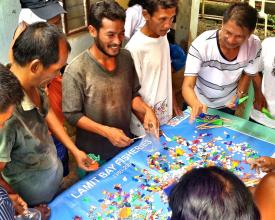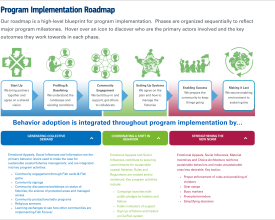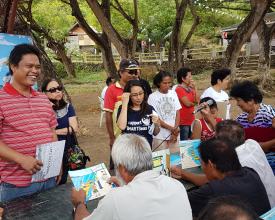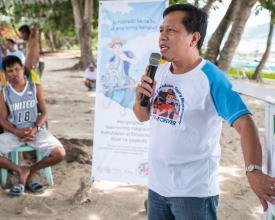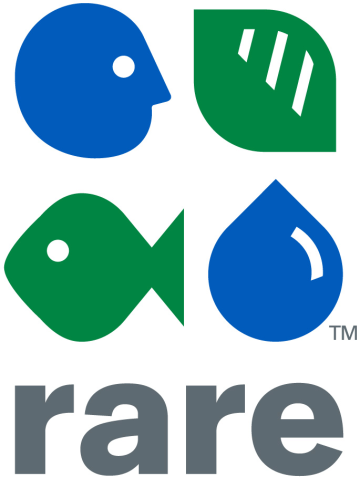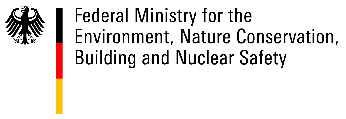
Engagement communautaire et adoption de comportements dans le cadre du programme Fish Forever

Pour que les AMP réussissent, la science, la gouvernance et l'application doivent être soutenues par l'adhésion et le respect de la part de la communauté. Dans le cadre du programme Fish Forever de Rare, des réseaux de réserves marines et d'accès gérés sont établis et renforcés en utilisant des approches éprouvées d'engagement communautaire et d'adoption de comportements à chaque étape du processus. Cela permet de s'assurer que les pêcheurs et les parties prenantes locales "s'approprient" la solution et sont incités à soutenir les efforts de protection et de conservation à long terme.
Contexte
Défis à relever
Le succès de la gestion des AMP dépend de la capacité à résoudre le conflit perçu entre la protection et la conservation des ressources marines et les besoins des communautés en matière d'alimentation et de moyens de subsistance.
Emplacement
Traiter
Résumé du processus
Dans le cadre du programme Fish Forever, les collectivités locales concluent un partenariat avec Rare pour œuvrer en faveur d'une pêche côtière durable. Les collectivités locales désignent une équipe chargée de la mise en œuvre de la campagne, qui bénéficie d'une série de formations, d'un accompagnement et d'un mentorat sur la manière d'appliquer les stratégies d'engagement communautaire et d'adoption de comportements en vue de la création et du renforcement de zones d'accès protégées et gérées. Elles reçoivent divers outils et ressources, qu'elles adaptent au contexte local et mettent en œuvre sur une période de 2 à 4 ans.
Blocs de construction
Formation sur l'engagement communautaire et le changement de comportement
Une série d'ateliers forme des équipes de collectivités locales et d'autres organisations de soutien à l'utilisation des connaissances comportementales pour inspirer l'action. Ils apprennent à utiliser la recherche qualitative et quantitative pour générer des connaissances, des approches participatives pour amener les gens vers des objectifs communs, et des tactiques qui aident à faire passer le groupe par différentes phases de changement, de la création d'une demande collective à la coordination du changement, puis au renforcement des normes. Ils s'entraînent à concevoir et à mettre en œuvre leurs propres activités, développent du matériel et évaluent leurs progrès.
Facteurs favorables
Volonté de l'administration locale - Disponibilité de fonds pour le matériel et les activités - Administration locale bien coordonnée - Personnel efficace et motivé
Leçon apprise
La formation doit être pratique et à la portée conceptuelle des bénéficiaires visés, des responsables de la mise en œuvre, des communautés et des collectivités locales. Les concepts académiques doivent être communiqués de manière simple et compréhensible pour être appréciés. Les exemples pratiques et les points positifs sont importants. Des conseils sur les prochaines étapes permettent de garantir la durabilité des efforts à long terme. Encourager la créativité et l'inventivité permettra aux communautés d'atteindre les objectifs avec un minimum de coûts et d'efforts. Les visites croisées et le partage d'expériences entre communautés ont plus d'impact que les conférences.
Outils et ressources
Au cours de leur formation, les équipes de campagne sont exposées à un large éventail d'outils et de ressources qu'elles peuvent utiliser pour développer et mettre en œuvre leurs campagnes d'engagement communautaire et d'adoption de comportements. Il s'agit notamment d'un cadre simplifié pour le changement de comportement qui couvre les leviers stratégiques et les tactiques qui peuvent être appliqués, des outils pour susciter des discussions sur les AMP et la pêche, tels qu'un jeu de pêche et des cartes illustrées, des feuilles de travail pour la planification de la campagne, et des modèles de collatéraux de marketing social qui peuvent simplement être adaptés à l'usage local.
Facteurs favorables
Les outils sont prototypés, testés et mis à jour régulièrement - Les utilisateurs ont la possibilité d'adapter la plupart des outils au contexte local.
Leçon apprise
L'objectif est de fournir aux équipes de campagne suffisamment de ressources et d'inspiration pour qu'elles puissent mener des campagnes elles-mêmes. Les outils eux-mêmes n'ont pas besoin d'être parfaits, car ils seront toujours utilisés de différentes manières. Tant que les concepts de base et les résultats d'une activité sont clairs, les équipes peuvent s'approprier les conseils et les adapter à leurs besoins.
Équipes de mise en œuvre des sites locaux
Les campagnes d'engagement communautaire et d'adoption de comportements ont été élaborées et mises en œuvre par des équipes basées dans les communautés. Ces équipes étaient généralement composées de membres du personnel de l'unité gouvernementale locale et de dirigeants communautaires locaux, tels que des chefs de pêche ou des organisateurs. Ce sont eux qui ont reçu la formation et les outils et ressources. Ils ont adapté les stratégies à leur propre contexte, ont proposé des idées d'exécution et ont mis en œuvre les activités.
Facteurs favorables
Désignation officielle par le chef de l'exécutif local (maire) - Représentation des parties prenantes autres que le gouvernement local - Crédibilité et réputation au sein de la communauté
Leçon apprise
Il est préférable d'avoir une équipe d'au moins trois personnes, afin que le travail ne devienne pas écrasant et que l'équipe dispose de talents et d'intérêts divers. L'équipe idéale est composée d'une personne bien ancrée dans le gouvernement, qui peut obtenir des approbations et des budgets, d'une personne créative et capable d'utiliser des outils de base pour la conception, et d'une personne bien acceptée par la communauté qui sait comment s'engager et faciliter. Ils doivent tous savoir comment mobiliser des bénévoles et avoir des compétences de base en matière de gestion de projet.
Impacts
Sur 20 sites aux Philippines, des améliorations significatives ont été constatées au niveau des paramètres sociaux, tels que l'augmentation de la participation, de la confiance et de la cohésion, l'évolution positive des connaissances et des attitudes, et la diminution des violations. Les études menées dans l'eau sur ces sites ont également révélé une augmentation de l'abondance et de la biomasse des poissons à l'intérieur et à l'extérieur des zones d'interdiction de pêche, en particulier sur les sites qui ont maintenu leurs campagnes d'engagement communautaire pendant plus de quatre ans.
Bénéficiaires
Les gouvernements locaux et les organisations communautaires, les responsables de la pêche et, en fin de compte, les pêcheurs et leurs communautés.
Objectifs de développement durable
Histoire

Pendant des décennies, la pêche à la dynamite à Bindoy était très répandue et intergénérationnelle, voire routinière. Edgar Torres, un pêcheur, raconte : "Je n'avais pas peur de la pêche à la dynamite parce que nous attrapions beaucoup de poissons. Des sacs de poissons".
En 1998, le maire Valente Yap savait qu'il devait faire quelque chose. Le récif était miné par la pêche illégale depuis des années et il s'inquiétait de l'impact sur l'alimentation locale et la sécurité de l'emploi. Pendant les deux décennies qui ont suivi, il s'est donné pour mission de lutter contre la pêche illégale.
Tout d'abord, il s'est efforcé de convaincre les pêcheurs locaux d'accepter la création d'une zone marine protégée (ZMP). Les pêcheurs ont d'abord protesté contre cette idée, craignant l'impact à court terme de la fermeture de l'accès au récif foisonnant de Mantalip. Il a ensuite renforcé l'équipe locale chargée de l'application de la loi afin de cibler les pêcheurs illégaux utilisant des méthodes telles que la dynamite et le cyanure.
Le maire Yap et le gouvernement municipal ont également entrepris de changer les attitudes à l'égard de la pêche illégale, non pas en dénonçant les comportements illégaux, mais en instaurant une éthique de la conservation à l'échelle de la communauté. En 2012, Bindoy s'est associé à Rare pour mener une campagne Rare Pride en faveur de la pêche durable, dans le but d'inciter la communauté à se concentrer non plus sur les gains à court terme, mais sur les avantages à long terme d'un comportement durable.
Richard Balauro, employé municipal, a dirigé la campagne de fierté de Bindoy. Richard et son équipe ont organisé des événements et des ateliers participatifs avec des organisations populaires, mis en place des panneaux d'affichage et suscité des conversations. Ils ont organisé des événements tels que la journée des pêcheurs et le festival Libod Sayaw, où les habitants ont rencontré la mascotte de la fierté de Bindoy, Lovie, un vivaneau à points noirs, l'espèce que l'on trouve sur le récif de Mantalip.
Selon le maire Yap, l'engagement de la communauté était essentiel pour la transformation de Bindoy. "Nous ne pouvons pas mettre en œuvre l'application de la loi et tous ces programmes pour l'environnement sans le soutien des organisations populaires", explique-t-il. "Le marketing social de Rare a pu nous aider à changer la façon de penser de nos pêcheurs et des habitants des barangays côtiers, et [leur montrer] que ce que nous faisons est pour leur bien-être."
La campagne a aidé des pêcheurs comme Edgar Torres à comprendre que leur relation avec l'environnement marin devait changer. "Lorsqu'il a été question de faire de Mantalip une zone protégée, je me suis opposé à la proposition", explique-t-il. "La campagne Pride m'a convaincu de changer d'avis. Je me suis concentré sur l'avenir de ma famille. C'est devenu mon objectif : pêcher de manière responsable pour que mes enfants aient de meilleurs lendemains.
